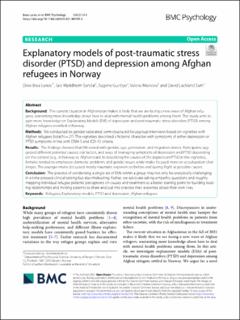| dc.contributor.author | Larios, Dixie Janice Brea | |
| dc.contributor.author | Sandal, Gro Mjeldheim | |
| dc.contributor.author | Guribye, Eugene | |
| dc.contributor.author | Markova, Valeria | |
| dc.contributor.author | Sam, David Lackland | |
| dc.date.accessioned | 2023-01-19T14:04:15Z | |
| dc.date.available | 2023-01-19T14:04:15Z | |
| dc.date.created | 2022-01-13T11:05:03Z | |
| dc.date.issued | 2022-01-04 | |
| dc.identifier.issn | 2050-7283 | |
| dc.identifier.uri | https://hdl.handle.net/11250/3044706 | |
| dc.description.abstract | Background: The current situation in Afghanistan makes it likely that we are facing a new wave of Afghan refugees, warranting more knowledge about how to deal with mental health problems among them. This study aims to gain more knowledge on Explanatory Models (EM) of depression and post-traumatic stress disorders (PTSD) among Afghan refugees resettled in Norway.
Methods: We conducted six gender-separated, semi-structured focusgroup interviews based on vignettes with Afghan refugees (total N = 27). The vignettes described a fictional character with symptoms of either depression or PTSD symptoms in line with DSM-5 and ICD-10 criteria.
Results: The findings showed that EM varied with gender, age, generation, and migration stories. Participants suggested different potential causes, risk factors, and ways of managing symptoms of depression and PTSD depending on the context (e.g., in Norway vs. Afghanistan). In describing the causes of the depression/PTSD in the vignettes, females tended to emphasize domestic problems and gender issues while males focused more on acculturation challenges. The younger males discussed mostly traumatic experiences before and during flight as possible causes.
Conclusion: The practice of condensing a single set of EMs within a group may not only be analytically challenging in a time-pressed clinical setting but also misleading. Rather, we advocate asking empathic questions and roughly mapping individual refugee patients’ perceptions on causes and treatment as a better starting point for building trusting relationships and inviting patients to share and put into practice their expertise about their own lives. | en_US |
| dc.language.iso | eng | en_US |
| dc.publisher | BMC | en_US |
| dc.rights | Navngivelse 4.0 Internasjonal | * |
| dc.rights.uri | http://creativecommons.org/licenses/by/4.0/deed.no | * |
| dc.title | Explanatory models of post-traumatic stress disorder (PTSD) and depression among Afghan refugees in Norway | en_US |
| dc.type | Journal article | en_US |
| dc.type | Peer reviewed | en_US |
| dc.description.version | publishedVersion | en_US |
| dc.rights.holder | Copyright 2022 the authors | en_US |
| dc.source.articlenumber | 5 | en_US |
| cristin.ispublished | true | |
| cristin.fulltext | original | |
| cristin.qualitycode | 1 | |
| dc.identifier.doi | 10.1186/s40359-021-00709-0 | |
| dc.identifier.cristin | 1980235 | |
| dc.source.journal | BMC Psychology | en_US |
| dc.relation.project | Norges forskningsråd: 273645 | en_US |
| dc.identifier.citation | BMC Psychology. 2022, 10, 5. | en_US |
| dc.source.volume | 10 | en_US |

